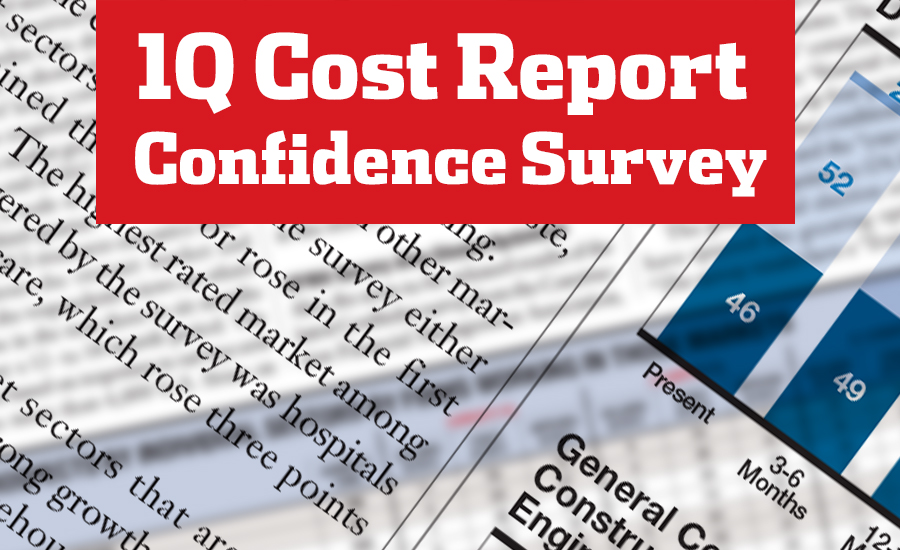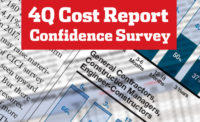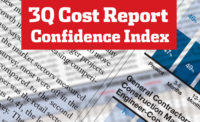The construction market is enjoying a decade of steady growth, and most sector executives don’t see an immediate cause for concern. But there is a growing sense of unease that the U.S. economy is softening, which could put an end to the industry’s expansion.
The contrast between current conditions and future market expectations can be seen in the latest results of the ENR Construction Industry Confidence Index survey. The CICI remained static at 59 in the first quarter of 2019, from the previous quarter ending last year. Of the 205 executives from large construction and design firms responding to the survey, many believe the market will begin to decline sometime in 2020.
This sense of an impending downturn doesn’t mean that the current construction market is in trouble. Only 3% of survey respondents believe it has started to decline now, and only 6% say it could start in three to six months. On the other hand, 25% speculate the market will start to shrink in the next 12 to 18 months, compared to only 15% who believe it will still be in a growth mode in that timeframe.
The CICI measures executive sentiment about the current market, where it will be in the next three to six months and over a 12- to 18-month period. A rating above 50 shows a growing market. The index is based on responses to surveys sent between Feb. 28 and March 27 to 6,000 U.S. companies on ENR’s lists of leading general contractors, subcontractors and design firms.
|
Related Link |
CFMA: CFOs Prepare for Trouble
The contrast between what the industry is seeing in the current market and what it expects to see next year is even more dramatic in the soon-to-be-released results of the latest Confindex survey from the Construction Financial Management Association, Princeton, N.J., which show that CFOs are worried about the market climate in 2020.
Each quarter, CFMA polls 200 CFOs from general and civil contractors and subcontractors. The CFMA Confindex is based on four separate financial and market components, each rated on a scale of 1 to 200. A rating of 100 indicates a stable market; higher ratings indicate market growth.
“The Confindex fell from 114 in the previous quarter to 109 in the current quarter,” says Stuart Binstock, CFMA’s CEO, noting it is the lowest rating since late 2010, when the industry was struggling to climb out of a deep recession.
The bigger story is how the market is being viewed. The forward-looking “general business conditions” component plunged 11 points, to 102, while the “year-ahead outlook” took a similar dive, falling 10 points, to 95.
On the other hand, the Confindex components associated with the current market were stable. The “financial conditions” component remained steady at 115, while the “current conditions” component also was unchanged at 121.
Worrying About the Bottom Line
Even so, industry execs are watching news about the U.S. economy with growing concern. “I don’t know if it is what [CFMA members] are seeing in the market, or what they are hearing from economists, but they are worried about next year,” says Anirban Basu, CEO of economic consultant Sage Policy Group, Baltimore, and a CFMA adviser.
Basu says CFO members of CFMA are more focused on the bottom line than on markets. “There is a lot of work out there, but workers to do that work are getting more expensive, which means increasing volume does not necessarily mean increased profits,” he points out.
Despite the active market, firms are not necessarily awash in cash. Only 29% of CICI survey respondents report higher profits compared to this time last year, while 14.5% said profits were actually down. This compares to a year ago, when 37.1% said profits were up year-over-year, and only 11.8% said they had fallen.
Binstock notes a similar trend in the Confindex survey. In the last quarter, 39% of respondents believed that profits would be up next year, compared with the 27% who thought profits would be in decline, he says. The current quarter’s responses are in sharp contrast to the last quarter, with only 20% believing profits will be up next year, as opposed to the 37% who believe profits will be down.
One area where companies are finding a little relief is in materials prices, with current numbers indicating that increases seem to be more modest than expected even in the wake of the Trump Administration’s imposition of tariffs on such materials as steel, aluminum and lumber. ENR’s CICI survey asked whether firms were seeing upward price pressure on any materials or equipment.
While 70.4% of CICI survey execs said they were seeing price pressures, this is down sharply from the 87.2% in the third quarter survey and 80.5% in the fourth quarter who saw rising prices. “People are finding that the impact of the tariffs is less than they anticipated,” Basu says.
The market may be solid right now, but industry firms are having to pay a premium to hire enough people to do all the work. “If the market goes into recession next year, companies will be stuck with a lot of high-priced people with not enough to do,” says Basu. “So CFOs are beginning to look at how to protect the bottom line if the downturn comes, going into a recession-planning mode.”




